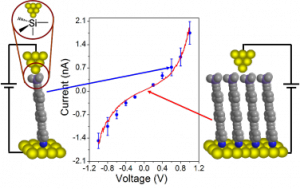Nanoscience
Our research interests lie on the fabrication and characterization of mono and multilayered films of organic and hybrid organic-inorganic materials. Thin solid films exhibit a wide range of applications in sensing, solar energy harvesting, catalysis, electronics, green chemistry, lubrication, functional surfaces, simulation of biological systems, etc. Our group has exceptional facilities in the fabrication of thin solid films by self-assembly, Langmuir-Blodgett, spin-coating, and dip-coating technologies. The group also has access to a wide variety of characterization techniques including thermodynamic, spectroscopic, electrochemical, and advanced microscopy techniques. In particular, we are currently working on the following topics:
Molecular Electronics
Molecular electronics is a fascinating multidisciplinary field of research due to potential applications in future sensor devices, computing technology, catalysis, solar-energy harvesting and related fields. Molecular electronics hinges on the fundamental idea that novel devices can be created by using single molecules or small assembles of molecules, i.e., monomolecular films. By making functional molecules, such as wires, switches, rectifiers, etc., synthetic chemists add a unique ingredient of variability and structural control that cannot be achieved with equivalent solid state devices. Since single molecules constitute the smallest stable structures possible, this miniaturization is the ultimate goal for shrinking electrical circuits.
The work in our group is highly interdisciplinary involving close collaboration with synthetic chemists (Prof. P.J. Low from Perth University and Prof. J.L. Serrano from Zaragoza University), experimentalists for electrical measurements and imaging data using Scanning Tunneling Microscopy and related techniques (Prof. Richard J. Nichols and Prof. Simon J. Higgins from the University of Liverpool and Prof. F. Pérez-Murano from CNM-CSIC Barcelona) and theoreticians (Prof. J. Ferrer, University of Oviedo). In particular we are working on the following issues:
- Uniformity of contact between metals
 and device-functional molecules
and device-functional molecules - Behaviour of metal-molecule contacts under applied electric fields
- Deposition of the second(top) contact electrode onto molecular films without damage to the molecular material, or penetration of the metal through the organic film
- Assembly strategies for precise placement of molecular materials within device structures
- Single Molecule conductance and Electrochemistry
Assembly of MOFs into thin solid films
Metal organic frameworks (MOFs) constitute a new family of nanoporous materials which have the lowest bulk density and largest void space reported until now. MOFs are formed by association of metal centers and organic linkers and offer a unique chemical versatility combined with a designable framework and an unprecedentedly large and permanent inner porosity. All these properties exceed the limitations of previously known porous materials such as zeolites, mesoporous silica or activated carbon.
In particular, the processing of MOFs as surface-attached thin films (SURMOFs) is a domain that has only recently been initiated but which is important for many applications, such as chemical sensors and membranes. Moreover, some SURMOF structures simply do not exist as bulk MOF powder or as a single-crystalline material but only as a thin film bound to an appropriate substrate. SURMOFs also offer other interesting possibilities, such as fabrication of heterostructures and chemical or structural modifications that are specific for the exposed external surface (top layer) of the films.
Our main interest in this topic is the fabrication, characterization and study of the performance in gas separation of mixed LB films formed by mixtures MOF/polymer in different proportions. These studies will allow us:
- Optimizing membrane thickness. Membranes will be assembled monolayer by monolayer and their properties will be analysed.
- Studying MOF-polymer interactions for different compositions and fabrication conditions.
- Characterizing physicochemical properties in terms of membrane composition and structure.
- Correlating the characteristics of pure compounds with membrane structure and properties.
This work is done in the framework of the European Project M4CO2 (http://www.m4co2.eu) coordinated by TU Delft (The Netherlands).





